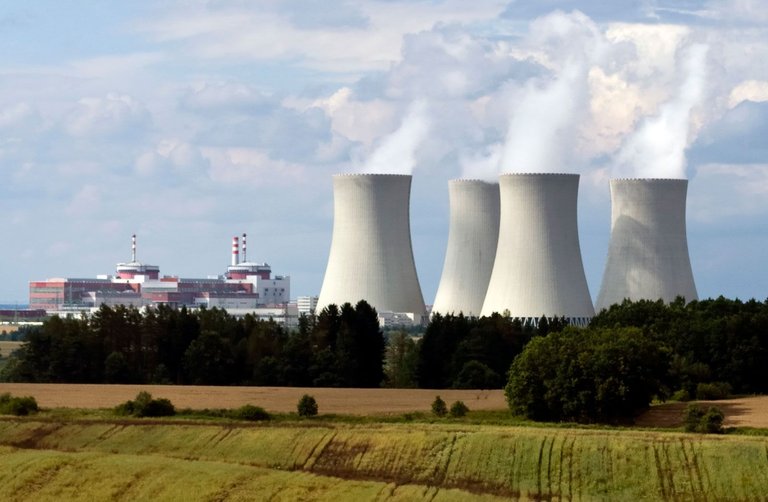LeoGlossary: Nuclear

Nuclear refers to the energy released from the nucleus of an atom, either through fusion or fission. Fusion is the process by which atomic nuclei combine to form a heavier nucleus, releasing energy in the process. This is the energy source of the sun and other stars. Fission is the process by which an atomic nucleus is split into two or more smaller nuclei, also releasing energy.
Nuclear energy can be harnessed and used in various ways, such as:
- Nuclear Power plants: These plants use nuclear fission to generate electricity. The energy released from fission is used to heat water, which creates steam that turns a turbine to generate electricity.
- Nuclear medicine: Nuclear energy is used in medicine to diagnose and treat diseases. Radioactive isotopes are used in imaging techniques such as positron emission tomography (PET) scans and single photon emission computed tomography (SPECT) scans. Radiation therapy is also used to treat cancer.
- Nuclear weapons: Nuclear energy is used in the production of nuclear weapons, which release a large amount of energy through nuclear fission or fusion.
- Nuclear propulsion: Nuclear energy can be used to power ships and submarines through nuclear propulsion.
- Space exploration: Nuclear energy is used in spacecraft to power instruments and communication equipment. Radioisotope thermoelectric generators (RTGs) are used to convert the heat generated by the decay of radioactive isotopes into electricity.
Overall, nuclear energy is a powerful force that has many practical applications, but it also requires careful handling and regulation to ensure safety and prevent misuse.
The term "nuclear" has two main meanings:
1. Relating to the nucleus of an atom:
- The nucleus is the central core of an atom, containing protons and neutrons. It holds most of the atom's mass.
- Nuclear forces hold the protons and neutrons together within the nucleus. These forces are much stronger than the electromagnetic forces that govern interactions between atoms and molecules.
- Nuclear reactions involve changes in the structure of the nucleus, releasing or absorbing energy in the process.
2. Relating to nuclear power or nuclear weapons:
- Nuclear power uses nuclear reactions to generate electricity. This can be done through nuclear fission, which splits the nucleus of an atom, or nuclear fusion, which combines two atomic nuclei.
- Nuclear weapons are explosive devices that release a massive amount of energy from nuclear reactions. These weapons can be incredibly destructive and have far-reaching consequences.
In everyday language, "nuclear" often refers to nuclear power or nuclear weapons due to their potential impact and historical significance. However, it's important to remember the broader meaning related to the atomic nucleus itself.
Here are some additional points to consider:
- Nuclear science is a vast field with many applications, beyond just power and weapons. It also plays a role in medicine, materials science, and other areas.
- The use of nuclear technology raises important ethical and safety concerns that need to be carefully considered.
History of Nuclear
The concept of "nuclear" stretches back much further than the discovery of atomic structure in the 20th century. Here's a glimpse into its historical Journey:
Ancient Greek Philosophy (6th-4th centuries BC):
- Democritus and Leucippus: Proposed the idea of atoms as the fundamental building blocks of matter, though their understanding lacked scientific basis.
19th Century Developments:
- John Dalton (1803): Introduced the atomic theory, laying the groundwork for modern atomic science.
- Marie Curie (1896): Discovered radioactivity, a phenomenon where atoms spontaneously emit energy and particles.
Early 20th Century Discoveries:
- Ernest Rutherford (1911): Proposed the nuclear model of the atom, with a central nucleus surrounded by electrons.
- James Chadwick (1932): Discovered the neutron, a neutral particle in the nucleus.
- Otto Hahn and Fritz Strassmann (1938): Achieved nuclear fission, splitting a uranium atom and releasing immense energy.
World War II and The Manhattan Project (1939-1945):
- Enrico Fermi: Led the team that achieved the first controlled nuclear chain reaction in 1942, paving the way for nuclear power and weapons.
- Development of the atomic bomb: The Manhattan Project in the United States aimed to develop atomic bombs for use in World War II.
- Atomic bombings of Hiroshima and Nagasaki (1945): The United States dropped atomic bombs on these Japanese cities, ending the war but raising ethical and humanitarian concerns.
Post-War Era (1945-present):
- Nuclear power development: Countries began exploring nuclear power for electricity generation, with both successes and challenges related to safety and waste disposal.
- Nuclear weapons proliferation: The Cold War era spurred an arms race between the United States and the Soviet Union, leading to a significant increase in nuclear weapons stockpiles.
- Non-proliferation efforts: Treaties and agreements were established to limit the spread of nuclear weapons and promote peaceful uses of nuclear technology.
- Continued research and applications: Nuclear science continues to evolve, with applications in medicine, materials science, space exploration, and other fields.
The history of nuclear is complex and multifaceted, marked by both remarkable advancements and profound ethical challenges. As we move forward, understanding this history is crucial for informing responsible decisions about the future of nuclear technology.
General:
Posted Using InLeo Alpha